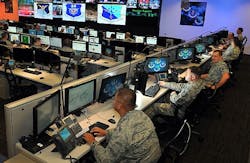Raytheon to build command-and-control system to synchronize cyber security and cyber warfare
SAN ANTONIO, Texas – U.S. Air Force cyber security experts needed the ability to synchronize a variety of cyber warfare weapon systems. They found their solution from the Raytheon Co. Cyber Solutions segment in Indialantic, Fla.
Officials of the Air Force Life Cycle Management Center at Joint Base San Antonio-Lackland, Texas, announced an $8.5 million contract to Raytheon Cyber on Monday for the Cyber Command and Control Mission System (C3MS).
The contract calls for Raytheon to design, build, and deploy a C3MS weapon system alternate operating location.
The C3MS will provide command, control, and situational awareness for Air Force and U.S. military cyber warfare forces, networks, and mission systems. It will provide overarching command and control for Air Force cyber domain responsibilities by ensuring reliable access, mission assurance, and use of networks and information systems worldwide.
The C3MS weapon system is the single Air Force weapon system that provides round-the-clock cyber warfare situational awareness, management, and control. It has five major sub components.
Related: DOD cyber security strategy to focus on defending military and national-interest networks
-- Situational awareness produces a common operational picture of friendly, neutral, and threatening cyber activities by fusing data from different sensors, databases, weapon systems, and other sources.
-- Intelligence, surveillance and reconnaissance (ISR) integrates cyber indications and warning, analysis, and other actionable intelligence products for planning and execution.
-- Planning develops long- and short-term plans for offensive and defensive cyber operations, and DOD Information Network Operations.
-- Execution represents the ability to generate and track cyber tasking orders.
-- Integration with other command-and-control nodes provides the ability to integrate Air Force-generated cyber effects with other Air Force and U.S. military cyber operations.
Related: Not your old timer's electronic warfare
One of the primary functions of the Air Force C3MS is to monitor and synchronize five Air Force cyber warfare weapon systems: the Air Force Cyberspace Defense (ACD) weapon system; the Air Force Cyberspace Defense Analysis (CDA) weapon system; the Air Force Cyberspace Vulnerability Assessment (CVA) / Hunter weapon system; the Air Force Intranet Control (AFINC) weapon system; and the Air Force Cyber Security and Control System (CSCS) weapon system.
The ACD prevents, detects, responds to, and provides forensics of intrusions into unclassified and classified networks. The CDA conducts defensive cyberspace operations by monitoring, collecting, analyzing, and reporting on sensitive information released from friendly unclassified systems, such as computer networks, telephones, e-mail, and Air Force websites.
The CVA / Hunter executes vulnerability, compliance, defense, and nontechnical assessments, best-practice reviews, penetration testing, and hunter missions on Air Force and DOD networks and systems. The AFINC is the top-level boundary and entry point into the Air Force Information Network, controlling the flow of all external and interbase traffic through standard, centrally managed gateways.
On this contract Raytheon Cyber will do the work in San Antonio, Texas, and should be finished by April 2018. For more information contact Raytheon Cyber Solutions online at www.raytheoncyber.com, or the Air Force Life Cycle Management Center at www.wpafb.af.mil/aflcmc.
Learn more: search the Aerospace & Defense Buyer's Guide for companies, new products, press releases, and videos

